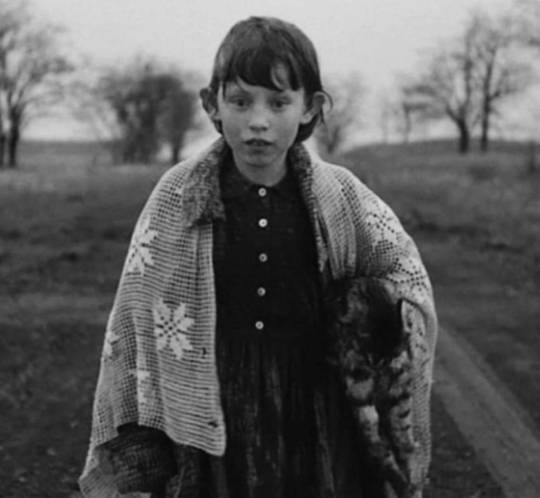#bela tarr
Explore tagged Tumblr posts
Text
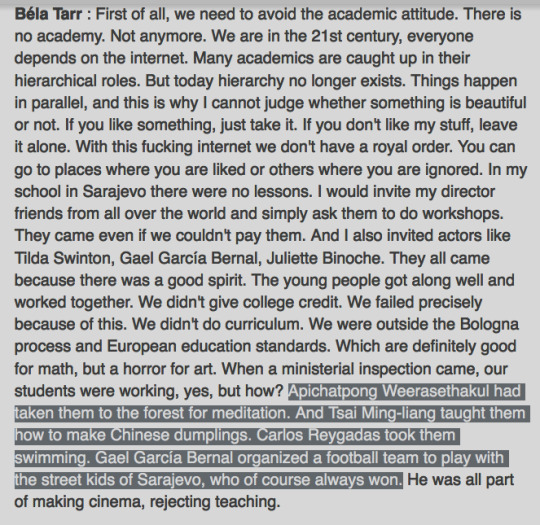
okay but, that's the dream
(Bela Tarr reflecting on film.factory, which went bankrupt after 3 years)
#i laughed out loud at chinese dumplings BUT PLS LET'S MAKE DUMPLINGS TSAI MING LIANG#apichatpong weerasethakul#LET ME MEDITATE WITH HIM#tsai ming liang#reygadas ehh but i do like swimming#gael garcia bernal#i'll just watch from the side w/e#someone on twitter brought film.factory up i had to go back and reminisce#film.factory#bela tarr#juliette binoche#tilda swinton
226 notes
·
View notes
Text
FIRST TOTAL SOLAR ECLIPSE

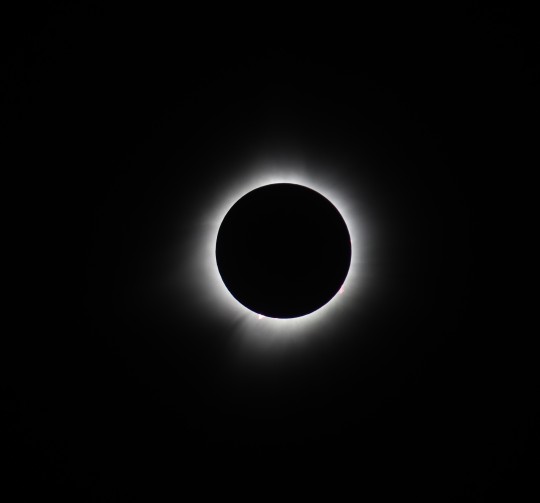
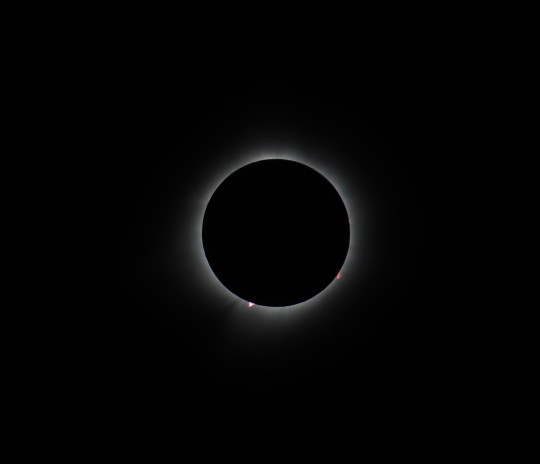
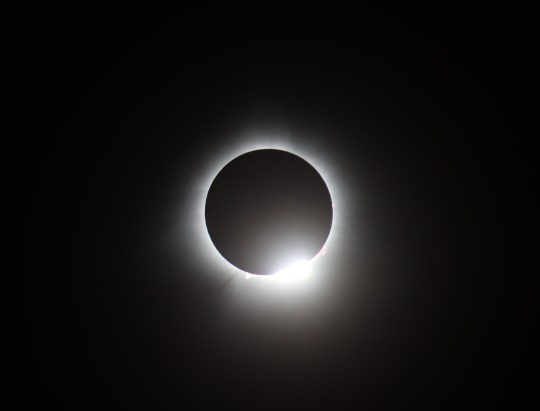
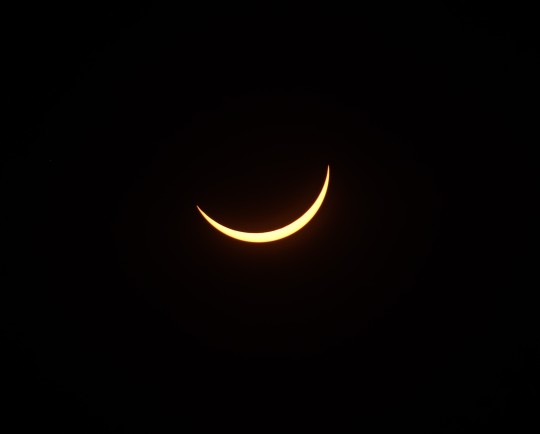
Images from my first total solar eclipse, depicting the outer corona, inner corona, prominent prominences, diamond ring, and the partial phase. Photos taken by Dan.
A black sun. Never had I seen a black sun, that insignia of melancholia that will forever remind me of Kristeva, which will forever remind me of M’s suicide—it was one of the few books M had with her at the very end, the book that her mother believed was the key to why she did it.
Black sun. On the day of—or day after—M’s death anniversary. I had been weeping for days when I found myself beneath that darkening sky.
*
What’s the difference between a partial and a total eclipse? I vaguely remember going onto the playground with some glasses as a child, but I don’t remember what I saw in the sky. What’s the big deal? The sky goes dark for a few minutes. It can’t be much different from the onset of night.
Wrong.
The rhapsodic scientists I listened to on various podcasts convinced me that there is really no comparison between a partial and total eclipse. I tried to hatch a last-minute plan to get myself in the path of totality. In the days leading up to the eclipse, I would be at the French King Bridge for M’s death anniversary. The only person I knew in Western MA, besides M’s mother, was my poet friend Ethan. So I asked him if he had a plan to see the eclipse.
I did not know, when I texted him out of the blue, that his parents lived in the path of totality in northern Vermont, that his father Dan was an astronomer (communist astronomer!) and eclipse chaser (this was his 14th eclipse), that Dan had even organized the local viewing event and wrote a book on the history of astronomy. At Ethan’s parents’ house there were literally photographs of eclipses mixed in with the family photos (see below). His father had even built a little observatory on his land. I had, in the most haphazard fashion, found the perfect guide to my first total solar eclipse.
Dan brought his equipment to the eclipse viewing: cameras, filters, binoculars, and a $4000 hydrogen alpha telescope that we used before the eclipse to look at the sun’s prominences and a sunspot on the surface. He enthusiastically answered all my questions. How had the Babylonians worked it out so long ago? Why does the wind pick up when the eclipse begins? Why is the sun’s corona so much hotter than the sun’s surface? (It’s still a mystery to the scientists…) Why why why. (People often tell me that I always ask a lot of questions—almost like an eternally curious child.)
The eclipse. It is not like the dimming of sunset, with its orange hues and plunge into the horizon, the low angle. It is a light unlike any light I have seen before, a strange dream-like atmosphere, a gray yet shimmering unreality, the air suddenly cold, the birds in a confused tumult. The uneven temperature of the atmosphere makes the wind pick up as the moon slowly covers the sun. Though the light was not the gold of sunset, you could see a band of orange on every horizon like a 360 degree sunset, an eerie gloaming that electrifies your skin.
A silence descended on the field as the moment of totality approached. Then, audible gasps—we couldn’t believe what we were seeing. I think the first thing I said was, “Holy. Shit.” Nothing prepared me for the numinous beauty of the sun’s corona, those elegant wisps of bright white light haloing the black sun. I think it’s probably the closest one can come to seeing God while alive on this earth. I cried during totality while observing the patterns in the corona through binoculars. A beautiful pink arch of plasma (a prominence) was visible toward the bottom of the sun. Dan pointed out Venus in the sky.
In the center of that black hole there is an abyssal silence
I don’t know how to describe it. Celestial indifference to human endeavor, human emotion. A kind of coldness in that heat, the heat of the corona, beyond even the fires of Hell. Then I can hear the angelic squall of the corona ringing over the landscape. It is a sound full of grace even as it cannot be called happy.
I can see why the ancients might interpret an eclipse as an augur of something deeply ominous, perhaps apocalyptic. The experience is, at once, sublime, ecstatic, and deeply unnerving—all your perceptual faculties are telling you that something is wrong. The ongoingness of the world and its rules cannot be taken for granted, for the sun went black, not in my dream, but in the afternoon sky.
And just as soon as it began, it was over. We had almost 3 and half minutes of totality. I was surprised by how quickly the sky brightened, how much light we get when the sun is almost completely covered.
One day the moon will float away. There won’t be any more total solar eclipses. Be grateful you were alive during this slice of cosmic time.
youtube
This is my favorite scene in all of cinema, from Béla Tarr's Werckmeister Harmonies. Watch drunkards reenact an eclipse in a drab Hungarian bar...

Ethan and communist astronomer dad!
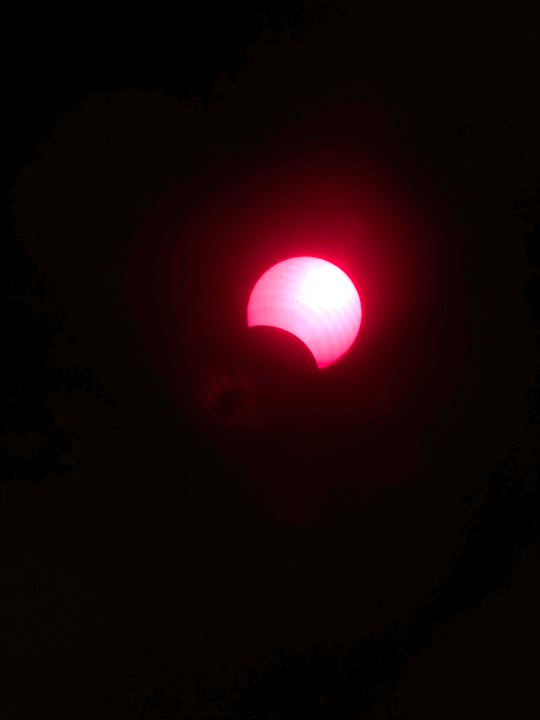


I even got eclipse-branded maple syrup (peak Vermont)

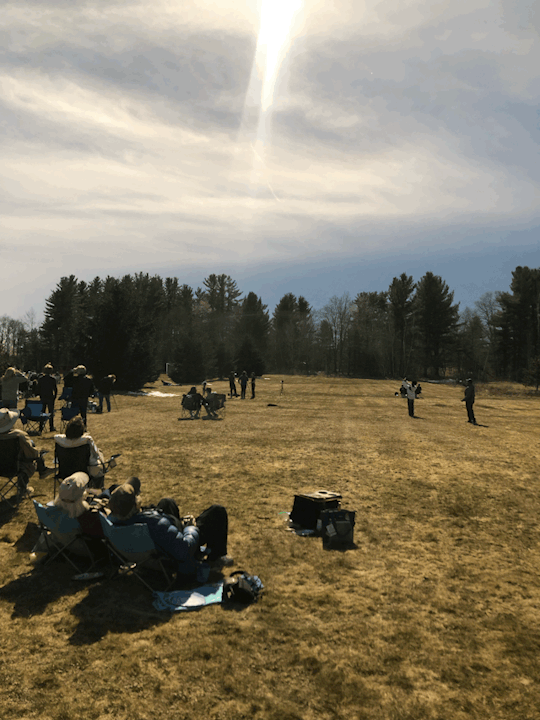

#eclipse2024#eclipse#total solar eclipse#solar eclipse#Werckmeister Harmonies#film#bela tarr#great american eclipse#béla tarr
41 notes
·
View notes
Text

Satantango
Bela Tarr 1994
16 notes
·
View notes
Text

Werckmeister Harmonies (2000) - dir. Béla Tarr
#werckmeister harmonies#béla tarr#bela tarr#cinema#movie scenes#art house cinema#movie gifs#film gifs
9 notes
·
View notes
Text



Ágnes Hranitzky & Béla Tarr, {2000} Werckmeister harmóniák (Werckmeister Harmonies)
#film#gif#Ágnes Hranitzky#béla tarr#Werckmeister harmóniák#werckmeister harmonies#agnes hranitzky#bela tarr#werckmeister harmoniak#2000#female filmmakers#black and white#male filmmakers#subtitles#dancing#people#men#2000s#feature length#hungary#italy#germany#france
8 notes
·
View notes
Photo
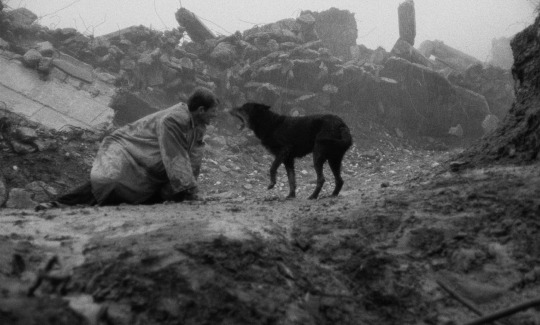
Kárhozat (1988) dir. Béla Tarr
139 notes
·
View notes
Text
Bir şeyler bana hep sonraki anda delireceğimi söyledi. Ama öyle olmadı. Üstelik delirmekten korkmuyorum. Delilik korkusu bir şeylere sadık kalma anlamına gelir. Henüz bir şeye sadık değilim. Her şeyin bana sadık olmasına rağmen, sadık olduğum bir şey yok. Onlara bakmamı istiyorlar. Nesnelerin olguların çaresizliğine. Penceremin dışındaki pis köpeğin, kurşini gökyüzünün altında, delicesine yağan yağmurda su içişine bakmamı istiyorlar. Acıklı çabalarını izlememi istiyorlar. Herkes, mezara girmeden önce konuşmaya çalışıyor. Zaten düştüler, konuşacak zamanları kalmadı. Beni delirtmek için nesnelerin bu geri dönülmezliğini istiyorlar. Bir sonraki anda ise delirmemi istiyorlar.
16 notes
·
View notes
Text



Damnation. Béla Tarr. 1988
64 notes
·
View notes
Text
youtube
kárhozat, bela tarr 1987
2 notes
·
View notes
Text
My top 20 new-to-me movies of 2024
1. An Elephant Sitting Still (2018, Hu Bo, China)

2. Straight Time (1978, Ulu Grosbard, USA)

3. Killers of the Flower Moon (2023, Martin Scorsese, USA)

4. Sátántangó (1994, Béla Tarr, Hungary)
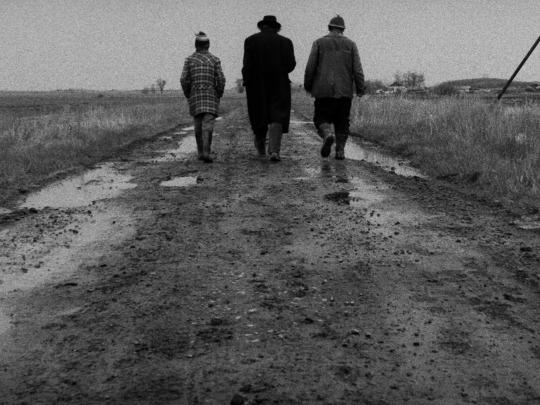
5. Bad Boy Bubby (1993 Rolf de Heer, Australia)

6. First Reformed (2017, Paul Schrader, USA)

7. Jane B. par Agnès V. (1988, Agnès Varda, France)

8. The Dirties (2013, Matt Johnson, Canada)

9. The Adventure of Faustus Bidgood (1986, Andy Jones/Michael Jones, Canada)

10. The Miracle Worker (1962, Arthur Penn, USA)

11. The Great Escape (1963, John Sturges, USA)

12. Tie Xi Qu: West of the Tracks (2002, Wang Bing, China)

13. Fear of a Black Hat (1993, Rusty Cundieff, USA)

14. Cemetery Man (1994, Michele Soavi, Italy)

15. Wolfwalkers (2020, Tomm Moore/Ross Stewart, Ireland)

16. Calvary (2014, John Michael McDonagh, Ireland)

17. Not a Pretty Picture (1976, Martha Coolidge, USA)

18. Real Life (1979, Albert Brooks, USA)

19. The Tenant (1976, Roman Polanski, France)
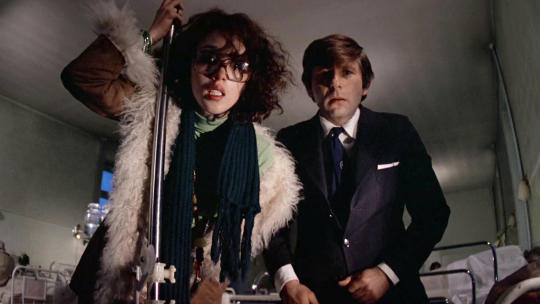
20. Red Rocket (2021, Sean Baker, USA)

#an elephant sitting still#hu bo#straight time#ulu grosbard#killers of the flower moon#martin scorsese#satantango#bela tarr#bad boy bubby#rolf de heer#first reformed#paul schrader#jane b. par agnes v.#agnes varda#the dirties#matt johnson#the adventure of faustus bidgood#andy jones#michael jones#the miracle worker#arthur penn#the great escape#john sturges#tie xi qu: west of the tracks#wang bing#fear of a black hat#rusty cundieff#cemetery man#michele soavi#wolfwalkers
6 notes
·
View notes
Text

we can by finding meaning...and that meaning ALWAYS comes from within...
2 notes
·
View notes
Text
Loved the deadpan humor of this piece by Agustín Fernández Mallo. It serendipitously ties all the threads of my summer together... I read novels by Fernández Mallo and Pavese this summer and am en route to Turin in the shadow of Nietzsche. I hope I won't lose my mind in Turin. I hope I won't wail “Mother, I am stupid,” never to recover my fragile wits again.
Should I stay in the room where Pavese suicided? (Maybe that would be grim but I am grim.)
*
When I tell people I am moving to Turin they always say the same thing:
Isn't that where Nietzsche lost his mind?
In fact, Geoff Rickly, the singer of a screamo band I was obsessed with as a teen, asked me this very question as we were chatting in the Moynihan Train Hall at Penn Station in NYC a couple weeks ago, right before I hopped on the Amtrak to DC. (A poster of Rickly's band Thursday is literally plastered on the wall behind my head as I type this from my childhood bedroom in Florida.)
Me: I'm moving to Turin soon.
Geoff: Isn't that where Nietzsche lost his mind?
Me: Yeah, when he witnessed the horse being flogged. Well, the story may be apocryphal...
Geoff: Ah, Turin Horse. Not my favorite Béla Tarr film...
Me: Yeah, it's not even about Nietzsche!
Geoff: Maybe obliquely...
Me: Werckmeister Harmonies is my favorite Béla Tarr.
Geoff: Damnation is mine.
Me: Sátántangó is pretty great.
Geoff: I like the book better.
Me: Oh, I love László Krasznahorkai. [How many times had I practiced pronouncing that unwieldy Hungarian name?? Well the practice paid off I guess... all for this one moment, probably the only time in my life I will have an occasion to utter "Krasznahorkai" aloud.]
#Agustín Fernández Mallo#friedrich nietzsche#nietzsche#literature#cesare pavese#bela tarr#film#László Krasznahorkai
4 notes
·
View notes
Text

MOVIES I WATCHED THIS WEEK #202:
HUNGARIAN CINEMA X 5:
🍿 ON BODY AND SOUL, my first film by Hungarian Ildikó Enyedi, was nominated for an Oscar in 2017. A very different and extremely romantic story of an unlikely couple. The man is an introverted treasurer in a slaughterhouse, crippled with withered arm. [So many Eastern European films take place in slaughter-houses!] The young woman is a new employee who is being ostracized because of her autistic behavior. There's not much in common between them, but they connect after finding out that every night they share the same dream, being a pair of deer in in a snowy forest. It's completely magical. 8/10. [*Female Director*]
[I didn't realize that the woman character was modeled tangentially after a real person, Temple Gardine, who's an inventor, academic and a proponent for the neurodiversity movement. Somebody on r/GuessTheMovie recognized it just from the cut of her yellow shirt!]
🍿 As I'm gearing the fortitude to watch his difficult Opus Magnum, I took in (Twice!) my first film by László Nemes, WITH A LITTLE PATIENCE (2007). It's a companion piece to his 'Son of Saul'. Told in a single 10 minutes shot, choreographed, intense, wordless and meandering. A young woman works in a dark office, and it's not clear what kind of office it is, until the very end. You can only hear unsettling ambiance and whispers, thuds and typewriters in the background: Your imagination can fear the worst.
It's strange that Nemes got into a public dispute with Jonathan Glazer last year, because of the latter's critique of the Palestinian genocide: This short is a condensed version of 'The Zone of Interest'. 10/10 - a must-see quiet masterpiece.
🍿 "My dinner with Zoltán". THE FIFTH SEAL (1976) is considered as one of the greatest Hungarian films, and is my second masterpiece by director Zoltán Fábri (After 'The Boys of Paul Street'). It's a dark and philosophical morality play exploring ethics, martyrdom and the moral choices one must make in life.
In the last year of the Second World War, four friends, a watchmaker, a carpenter, a book salesman and a bar owner, drink and smoke in a dingy tavern [Oh, how this place must stink!], and are having intense discussions all night. One of them posts a dilemma for the others: Would it be better to live as a slave and endure severe abuse but have a clear conscience - or to live as an abusive tyrant and have no conscience at all? They argue and struggle all night with their answers. But the next evening, the Hungarian gestapo barges in, and they really must face that question again, this time as if their life depends on it. Because it does. (Poster Above).
All that and Hieronymus Bosch's 'Garden of Earthly Delights' metaphors too. 9/10.
🍿 On the other hand, I didn't get the point of Zoltán Fábri's absurd comedy THE TOTH FAMILY (1969). A military "Major" who's Cuckoo for Cocoa Puffs lunatic, arrives at a small idyllic Austro-Hungarian village. Suffering from PSTD and in need of recuperation, he's supposed to stay there for two weeks. But then he discovers therapy by folding thousands of goddamn cardboard boxes (?) thus driving everybody around him mad. 3/10.
🍿Also, PROLOGUE (2004), my first by Béla Tarr, as I prepare to dive into His world. I picked the shortest one he made, a single 5-minute dolly shot simply of people standing in line (for food). Poverty / misery. I should also watch the “Visions of Europe” anthology, which this is part of.
🍿
I haven't seen 'Inherent Vice' yet, but of all the other Paul Thomas Anderson's movies, my top rankings goes:
1. For the hungry boy.
2. Phantom Thread.
3. The master.
4. There will be blood.
and because of the first clip, I had to see PHANTOM THREAD again. It's a timeless masterpiece. The Jonny Greenwood ethereal score and the meticulous script, as well as Vicky Krieps graceful beauty are unmatched. Three personalities fight nearly to the death for love and control in a dance of power imbalance. A demanding and exacting "couturier", the waitress whose radiance he can't resist, and his fastidious, devoted sister. And poisonous mushrooms to boot. Re-watch ♻️. A perfect 10/10.
Extras: JUNUN is a musical documentary from 2015. PTA joined Jonny Greenwood (and his collaborator, Israeli poet Shye Ben Tzur) to an ancient castle in the blue city of Jodhpur, where they jammed and recorded some Hindustani inspired album.
Also: HAIM / VALENTINE (2017) was another, forgettable studio recording he did. The Haim sisters singing 3 songs, during the 'Licorice Pizza' shoot.
🍿
MASAKI KOBAYASHI X 2:
🍿 After 'Harakiri', and before sitting down to watch his acclaimed 9-hour-long 'The human condition', I savored SAMURAI REBELLION (1967), a near-perfect Jidaigeki tragedy. Heroic Toshiro Mifune, introduced as a 'henpecked husband' re-discovers his true Samurai spirit, when his daughter-in-law is being kidnapped by his superior. Classically-austere, sparse and meditative like a Zen garden. The story about defying injustice and finding domestic love is graceful and gripping from the first to last frame. 💯 score on Rotten Tomatoes. 9/10.
🍿 YOUTH OF THE SON (1952) was Kobayashi's first film, a simple and lighthearted family comedy-drama, unlike his serious, later works. An open-minded writer-father and his loving wife watch over their two teenage boys as the younger discovers girls, and the older one gets in a bit of trouble with the police. With frequent Ozu cast members Chishū Ryū and Kuniko Miyake.
🍿
THE NIGHT IT RAINED is a strangely-controversial 1967 Iranian documentary. A story was published in the papers about an heroic 12 year old boy from some rural village who supposedly saved a train from derailing after noticing that the bridge it approaches had been washed off in the rain. The film crew interviewed everybody involved in the story in order to discover the exact truth of the event. But like Rashomon, after hearing the conflicting versions of the story, the actual 'truth' remains ambiguous.
🍿
A PURE FORMALITY (1994), my 4th film by Giuseppe ("Cinema Paradiso") Tornatore. It's an old-fashioned two-hander cat-and-mouse mystery, whereby Gérard Depardieu is a recluse writer possibly-accused of murder by nameless police inspector Roman Polanski. But it's also a theatrical allegory that feels made-up, artificial and unreal. For example, the story which takes place all in one night uses the wettest scenario imaginable, a neglected police station that is extremely leaky and flooded during a relentless rain storm. And the symbolism of the shocking revelation at the end is a head-scratcher of the 'was it all a dream?' or 'Was he dead all along?' kind. Too intellectually-obtuse for me. Ennio Morricone did the score. 3/10.
🍿
HIGH SIERRA X 2:
🍿 "Hey! Sit down, have a cigarette...."
HIGH SIERRA (1941) was Humphrey Bogart's breakthrough film and at the same time, the one that helped his drinking buddy John Huston to transition from script-writing to directing. My third Ida Lupino vehicle. Bogie is a notorious career criminal who falls for two different women and then falls from the top of the mountain to his death. He also drives a goofy 1937 2-seater Plymouth De Luxe, and plays with (his own real-life) dog. No redemption for him.
🍿 I DIED A THOUSAND TIMES (1955) is a faithful, scene by scene CinemaScope remake of 'High Sierra'. Jack Palance and short haired bad-girl Shelley Winters bring their adopted dog to the hotel safe robbery. Instead of Willie Best who played the stereotypical "simple-minded" black bit in the original, here they used "Chico", a Mexican-American actor. Racial progress, I guess?... Also with Lee Marvin, and a split-second cameo of 19-year-old Dennis Hopper.
🍿
QUEEN ROCK MONTREAL is a concert film, recorded 24 and 25 November, 1981. A re-mastered Ultra-HD new copy looks great. But I was never into Queen, so this wasn't exactly for me.
🍿
DAVID ATTENBOROUGH X 3:
🍿 I was recommended to see Attenborough's latest 3-part nature series SECRET WORLD OF SOUND. Extraordinary footage in the famous BBC style, with amazing close ups, microscopic details, cutting edge audio, it gets into snake's brains, lion's mouths, bee's eyes and birds assholes.
🍿 DAVID ATTENBOROUGH MEETS PRESIDENT OBAMA. In 2015, he sat for an interview about the Natural World with Obama at The White House, but instead Obama interviewed him!
[In hindsight, what a disappointment did the Obama legacy turned out to be! How the transformative spark full of hope, fizzled into middle of the road Neo-liberal cosmetics, with zero achievements that will out-last Trump. What a pity!] [*Female Director*]
🍿 It's only a clip from one of his nature shows, but my interest came from the story of the CHRISTMAS ISLAND RED CRAB MIGRATION, where 120 million crabs gather to spawn.
🍿
The Danish KNIGHT OF FORTUNE was nominated for an Oscar this year. A grieving, old widower cannot bring himself to open the casket of his dead wife and view her corpse. it's typically Danish, slow, unexpectedly morbid and uplifting at the same time. 8/10.
🍿
A BUNCH OF SHORTS:
🍿 FOOD (1992) is Jan Švankmajer's final short film (So far; He's still alive, and could surprise us all!). It's his most accessible, my favorite, and one of the most disgusting things I've ever seen. Think Czech cuisine from the 30's or 50's, jellied, congealed and unidentified dishes, with their slurping, guttural sounds, stick it in a surreal meat grinder, cover it with murky sauces and dirty condiments, and you're halfway there. Best film of the week - 10/10 on Yelp.
🍿 THE LUNCH DATE (1989) a masterful little story that won the Oscar, the Short Film Palme d'Or and was later selected for the 'National Film Registry'. An elderly woman misses her train at 'Grand Central Terminal' so she goes to the diner and orders a salad. But when she comes to her table, after fetching a fork from the counter, she finds a black man sitting and eating the salad! 8/10.
🍿 TEDDY GRAY'S SWEET FACTORY, an absolutely delightful 2011 story from documentarian Martin Parr. It tells of a small family-owned confectionery factory near Birmingham, England, which still produces old-fashioned, hand-made sweets. A must see! 8/10.
🍿 SLATE (1976), another of Krzysztof Kieślowski's shorts. A quick behind-the-scenes montage from when they were using the clapboard shooting the movie 'The Scar'.
🍿 TOMATOS ANOTHER DAY (1934) was a weird avant-garde short with unique dadaist aesthetics. Absurdly-stilted and artificially-played satire of a love triangle, it's like a 100 year old minimalist Lynch'ian joke.
🍿 A GUN IN HIS HAND, an early Joseph Losey 'Copaganda' film (1945), part of MGM 'Crime does not pay' series. A top graduate of the police academy 'Breaks bad', and uses his technical knowledge to do crimes. M'eh.
🍿 LES MAINS NÉGATIVES (1978), my second by Marguerite Duras. A moving car drives through the dark streets of Paris before day break, while her repetitive voice asks to be remembered. Like 'Hiroshima Mon Amour', it's a poetic stream of consciousness about cave paintings memories and unrequited love. I lived there around that time, and one of the walking shadows she filmed, unnoticed and forgotten, may have been me. [*Female Director*]
🍿 CANTOS DE TRABALHO (1955). Ethnographic work. Five Brazilian work songs depicting manual laborers. Not too interesting.
🍿 "They say you die twice. One time when you stop breathing, and the second time a bit later on, when somebody says your name for the last time..."
B MOVIE (2009) my second documentary about street artist Bansky (And itself an extra from 'Exit through the gift shop'). Subversive, anti-corporate anarchist rebel, (with a sense of humor which shocks, mocks and rocks), still anonymous.
🍿 PORKY PIG'S FEAT (1943, colorized) is Frank Tashlin's highest rated film on Letterboxd. Porky Pig and Daffy Duck's try to escape the Broken Arms Hotel manager without paying their bill.
🍿 AN OSTRICH TOLD ME THE WORLD IS FAKE AND I THINK I BELIEVE IT (2021), a strange, post-modernist Australian stop motion animation about a telemarketer who fails at selling toasters, and instead meets a mysterious ostrich. 3/10.
🍿"Wedding is like a fortress. Those who are in want out, and those who are out want in..."
GEFILTE FISH (2008). Before her wedding, a young Israeli woman must kill a live carp and prepare the traditional jellied fish dish, as per her family customs. Okay... [*Female Director*]
🍿
THROW-BACK TO THE ADORA ART PROJECT:
Freddy Mercury Adora.
Bansky Adora.
🍿
(ALL MY FILM REVIEWS - HERE).
2 notes
·
View notes
Text
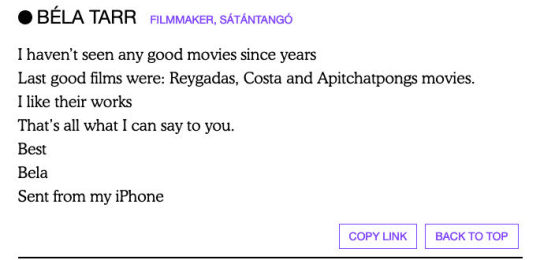
BELA TARR FOR SCREEN SLATE (2022)
#bela tarr#Screen slate#Film#filmmakers#directors#Tarr#Reygadas#Costa#apichatpong weerasethakul#sent from my iphone#lists#movie lists
7 notes
·
View notes
Text

Sátántangó (1994) - dir. Béla Tarr
#Sátántangó#béla tarr#bela tarr#satantango#hungarian cinema#cinema#movie scenes#movie gifs#film gifs#art house cinema
15 notes
·
View notes
